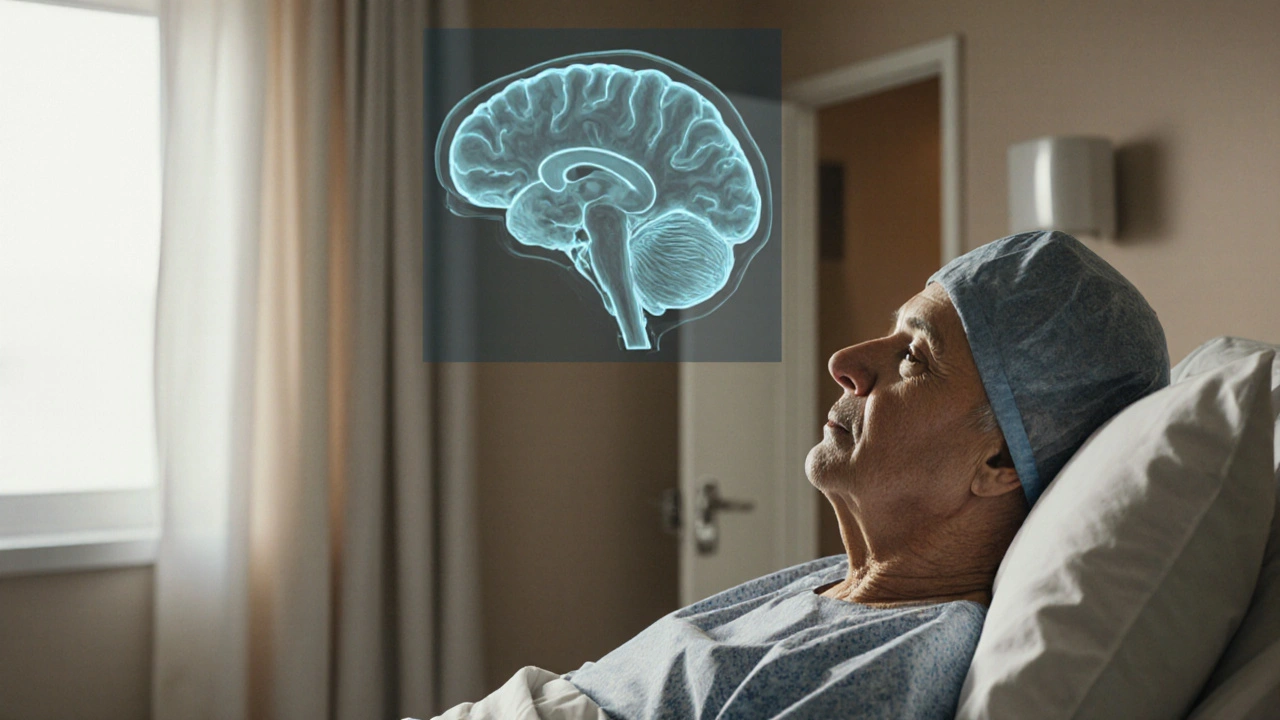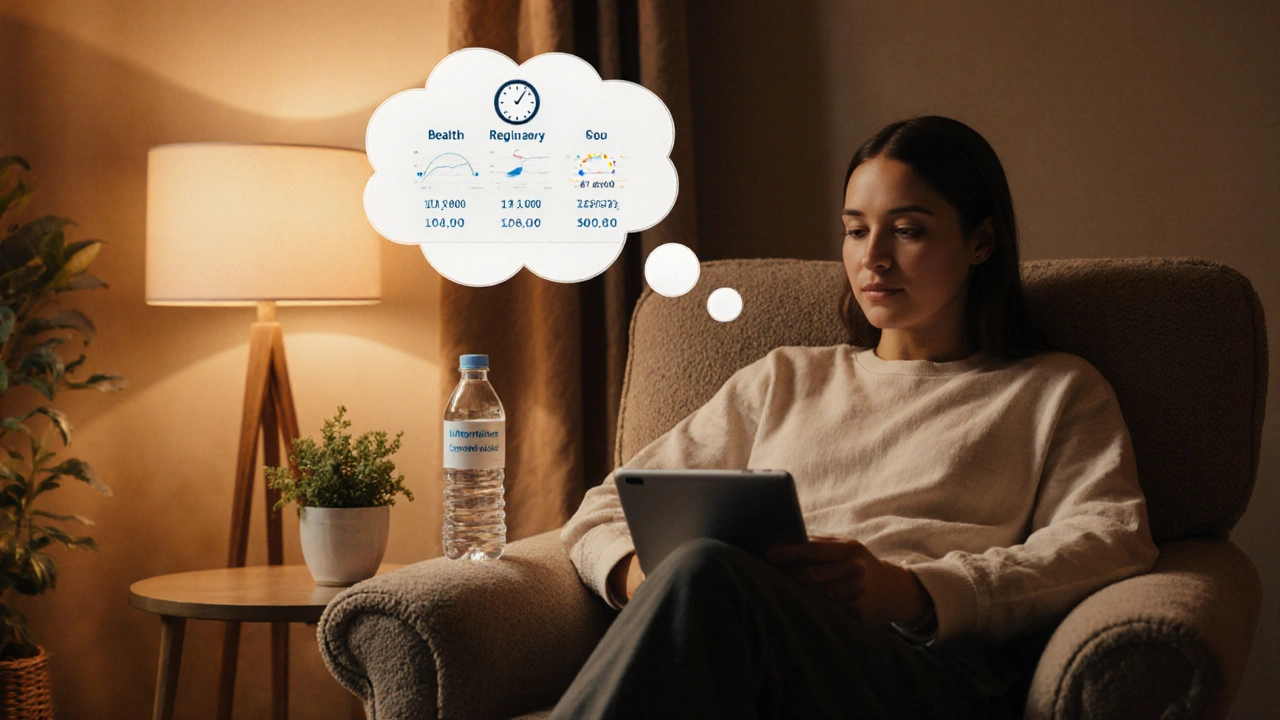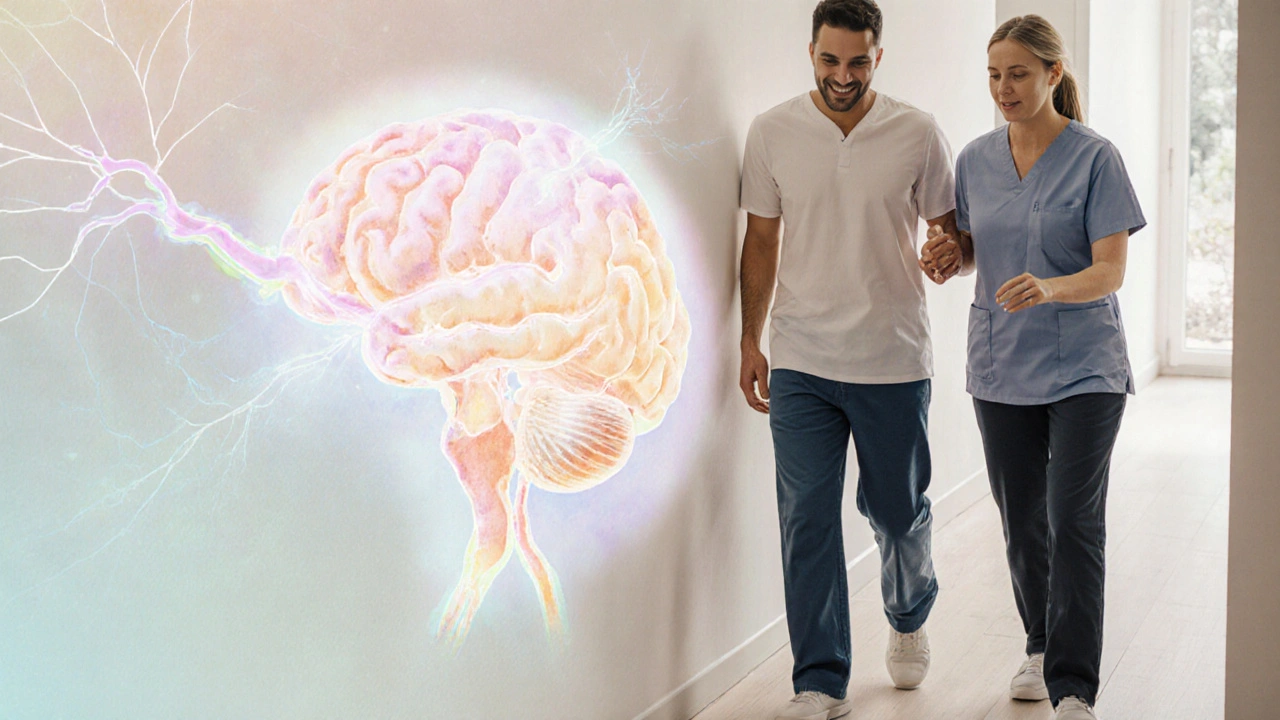
Post-Surgical Polyuria Tracker
This tool helps you track and assess your urine output after brain surgery to detect potential postoperative polyuria issues such as central diabetes insipidus or cerebral salt wasting.
Enter Your Urine Output (ml) for Today
Select Your Symptom
Tracking Log
Interpretation
Important Notes
• Urine volume exceeding 2 liters in 24 hours may indicate polyuria.
• Persistent thirst or dizziness could signal electrolyte imbalance.
• Report sudden changes to your medical team immediately.
When I woke up after my craniotomy, the first thing I noticed wasn’t the pounding headache but a relentless urge to pee. Postoperative polyuria is a condition where the body produces an unusually large volume of urine after surgery, especially procedures involving the brain or head trauma. Within hours, I was making trips to the bathroom every 30minutes, and the night‑time alarms kept jolting me awake.
TL;DR
- Head surgery can disrupt the brain’s control of water balance, leading to increased urination after head surgery.
- Two main culprits are diabetes insipidus (ADH deficiency) and cerebral‑salt wasting (excess sodium loss).
- Watch for sudden spikes in urine volume, extreme thirst, or low blood sodium and alert your medical team.
- Management includes fluid monitoring, hormonal replacement, and simple bladder‑training tricks.
- Recovery is gradual; stay patient, keep a log, and lean on rehab nurses.
Understanding Post‑Surgical Polyuria
In most people, the pituitary gland releases antidiuretic hormone (ADH) to tell the kidneys how much water to re‑absorb. After brain surgery or a severe head injury, that signaling can go haywire.
Antidiuretic hormone (ADH) is a peptide hormone that reduces urine output by increasing water re‑absorption in the kidney’s collecting ducts may be released in insufficient amounts, causing the kidneys to dump excess water. Alternatively, the body may lose too much sodium, pulling water out of the bloodstream and into the urine.
Why Head Trauma or Surgery Triggers the Issue
Three physiological pathways explain the link:
- Central Diabetes Insipidus (DI): Damage to the hypothalamus or the pituitary stalk interrupts ADH production. Without ADH, the kidneys can’t concentrate urine, leading to volumes of 3-5L per day.
- Cerebral Salt‑Wasting Syndrome (CSWS): Injury to brain tissue releases natriuretic factors, prompting the kidneys to excrete sodium and water together. The result is low serum sodium and high urine output.
- Neurogenic bladder dysfunction: The flow of nerve signals that coordinate bladder filling and emptying can be scrambled, making the bladder over‑active or under‑active.
Each pathway has distinct lab findings, but the clinical picture-frequent, large‑volume urination-looks similar.
Spotting the Red Flags
When you’re recovering from a skull operation, keep an eye on these signs:
- Urine volume exceeding 2L in a 24‑hour period.
- Persistent, unquenchable thirst (polydipsia).
- Dizziness, headaches, or fatigue that don’t improve with rest.
- Muscle cramps or confusion-possible signs of low blood sodium.
- Nighttime bathroom trips that interrupt sleep.
If any of these show up, flag them to your surgeon, neuro‑intensivist, or rehabilitation nurse right away.

How Doctors Diagnose the Problem
Medical teams usually run a set of labs and monitoring tools within the first 48hours after surgery:
- Serum sodium and osmolality: Low sodium points toward CSWS; normal‑high sodium leans toward DI.
- Urine specific gravity: Dilute urine (specific gravity <1.005) suggests ADH deficiency.
- Plasma ADH level: Direct measurement helps confirm central DI.
- Fluid balance chart: Nurses record every milliliter in and out to spot trends.
In some cases, a water‑deprivation test is performed once the patient is stable, to differentiate between DI and primary polydipsia.
Managing the Flood: Practical Tips
Once the cause is identified, treatment splits into two camps.
When Diabetes Insipidus Is the Culprit
- Desmopressin (DDAVP) - a synthetic ADH analogue given as a nasal spray, tablet, or IV. It reduces urine output dramatically.
- Track daily fluid intake; aim for a balance that avoids both dehydration and over‑hydration.
- Set a bathroom alarm or use a bedside commode to reduce nighttime trips.
If Cerebral Salt‑Wasting Is Driving the Loss
- Intravenous saline (normally 0.9% NaCl) to replace sodium losses.
- Fludrocortisone may be prescribed to help the kidneys retain sodium.
- Frequent electrolytes checks-usually every 6-8hours in the acute phase.
General Strategies for All Cases
- Bladder‑training schedule: Visit the bathroom every two hours, even if the urge isn’t strong.
- Use a “log book” or a smartphone app to note volume, time, and any associated symptoms.
- Lean on your rehabilitation nurse a health‑care professional who assists patients with daily functional recovery after surgery for education on fluid balance.
- Stay mobile-walking helps regulate the nervous system and can improve bladder control.
My Personal Recovery Timeline
Below is a rough sketch of the first four weeks after my operation. Your timeline may differ, but the milestones are common.
- Day 1-3: Urine output hit 4L/24h. I was given IV saline and a low‑dose DDAVP nasal spray. Nighttime bathroom trips were every 45minutes.
- Week 1: Desmopressin dose was titrated down; output settled at ~2.5L/24h. I started a bladder‑training log and set an alarm for every two hours.
- Week 2: Electrolytes normalized. I was allowed to drink as thirst dictated, but I kept the log to avoid over‑drinking.
- Week 3: Nighttime trips dropped to twice a night. I added short walks around the ward, which helped my mood and bladder rhythm.
- Week 4: Discharged home with a prescription for oral DDAVP and a floppy‑water bottle to track intake. I continue the log for a month post‑discharge.
The biggest lesson? Patience. Your brain needs time to re‑wire, and the kidneys need consistent signals to settle down.
Quick Comparison: Diabetes Insipidus vs. Cerebral Salt‑Wasting
| Feature | Central Diabetes Insipidus | Cerebral Salt‑Wasting Syndrome |
|---|---|---|
| Primary cause | ADH deficiency | Excess natriuretic factor release |
| Serum sodium | Normal to high | Low |
| Urine volume | 3-5L/24h | Variable, often >2L/24h |
| Treatment | Desmopressin, fluid balance | IV saline, fludrocortisone |
Take‑Away Checklist
- Record every bathroom visit and fluid ounce for the first two weeks.
- Report sudden spikes in output or any dizziness to your care team.
- Ask about desmopressin if ADH deficiency is suspected.
- Keep electrolytes checked if you’re on saline or diuretic therapy.
- Use a bedside commode or night‑light to reduce fall risk.

Frequently Asked Questions
Is increased urination normal after any brain surgery?
Not every procedure causes it, but any operation that touches the hypothalamus, pituitary, or surrounding tissue can disrupt ADH release. About 5‑10% of craniotomy patients develop some degree of polyuria in the first week.
How long does it usually take for urine output to normalize?
If treated promptly, most patients see a 50% reduction within 5‑7days. Full normalization can take 2‑4weeks, depending on the underlying cause.
Can I drink water freely, or should I limit intake?
Both over‑hydration and dehydration are risky. Follow the fluid‑balance chart your nurse gives you, and adjust based on urine volume and thirst cues.
What role does a rehabilitation nurse play in managing this issue?
They teach you how to log fluids, recognize red‑flag labs, and suggest simple bladder‑training techniques. They’re also the first line of contact if you notice sudden changes.
Are there long‑term complications if polyuria isn’t addressed?
Chronic dehydration can lead to kidney stones, electrolyte imbalance, and increased fall risk. Persistent ADH deficiency may require lifelong desmopressin.
Comments (20)
-
BJ Anderson September 29, 2025
The tracking tool you built is a solid first step, but pairing urine volume with serum sodium trends gives a clearer picture of whether the kidneys are over‑active or if the patient is losing electrolytes.
-
Alexander Rodriguez September 29, 2025
In fact, the simplest way to spot central diabetes insipidus is to check if the urine specific gravity stays below 1.005 while the serum sodium climbs.
-
Abhinav Sharma September 30, 2025
What we often forget is that the brain’s water‑balance system is a perfect example of homeostasis in action; a single disruption can cascade into a flood of downstream effects.
-
Welcher Saltsman October 1, 2025
Totally agree – keeping a calm routine, like setting a gentle alarm for bathroom breaks, can actually reduce that frantic feeling and help the nervous system settle down.
-
april wang October 1, 2025
First, it’s essential to understand that postoperative polyuria isn’t just a nuisance; it signals that the hypothalamic‑pituitary axis is out of sync, which can have systemic repercussions.
Second, the most reliable early marker is a sudden rise in 24‑hour urine output beyond 2 L combined with a serum sodium that either spikes or drops sharply, depending on whether the underlying mechanism is diabetes insipidus or cerebral‑salt‑wasting.
Third, nurses should be instructed to chart every void with the exact volume and time stamp, because patterns emerge only when data is granular.
Fourth, fluid replacement should be guided by serial labs rather than a fixed “drink X ounces per hour” rule; isotonic saline is preferred when sodium is low, whereas desmopressin is indicated for true ADH deficiency.
Fifth, patients often experience excessive thirst, so allowing sips of water on demand can prevent dehydration without overloading the bladder.
Sixth, a bedside commode or night‑light reduces fall risk during those inevitable midnight trips.
Seventh, education on bladder‑training techniques-such as scheduled voiding every 2‑3 hours-helps re‑establish normal bladder capacity.
Eighth, involving a rehabilitation nurse early ensures the patient gets hands‑on guidance and a quick way to report any alarming changes.
Ninth, if the urine remains dilute (specific gravity <1.005) despite normal sodium, consider a trial of low‑dose desmopressin while monitoring blood pressure.
Tenth, for cerebral‑salt‑wasting, fludrocortisone can be added to retain sodium, but it must be balanced against the risk of fluid overload.
Eleventh, always reassess labs every 12 hours in the acute phase because the underlying cause can shift from DI to CSWS or vice‑versa.
Twelfth, families should be briefed on the importance of the log so they can help maintain consistency once the patient leaves the hospital.
Thirteenth, keep an eye on peripheral edema; sudden swelling might indicate that fluid replacement is excessive.
Fourteenth, a multidisciplinary approach involving neurosurgery, endocrinology, and nephrology yields the best outcomes.
Fifteenth, remember that most patients normalize urine output within 2‑4 weeks if the underlying issue is addressed promptly.
Finally, maintain optimism – the body has a remarkable capacity to rebalance, and diligent monitoring is the key to a smooth recovery.
-
Christopher Munt October 2, 2025
💡 That’s a lot of useful info! I’d add that staying hydrated with small sips rather than large gulps helps keep the bladder from over‑distending.
-
Mike Creighton October 3, 2025
The cascade from hypothalamic injury to massive urine output reads like a tragic drama, where the villainous loss of ADH steals the body’s ability to hold onto water.
-
Sarah Posh October 3, 2025
Your poetic take on the hormonal drama is spot on; remembering that the brain’s messengers can be both healers and saboteurs gives patients hope that treatment can restore balance.
-
James Knight October 4, 2025
Frequent bathroom trips at night can ruin recovery sleep.
-
Robert Brown October 5, 2025
Skip the log and just force fluids.
-
Erin Smith October 6, 2025
Keeping a simple log is actually empowering; seeing the numbers can motivate you to stick to the plan and talk to the care team when something looks off.
-
George Kent October 6, 2025
BTW, "polyuria" is spelled with a y at the end, not an i; also, "urine" should be singular when referring to the fluid, not "urines".
-
Jonathan Martens October 7, 2025
It’s fascinating how the neuro‑endocrine jargon can turn a simple bathroom break into a multi‑disciplinary conference, isn’t it?
-
Kendra Barnett October 8, 2025
Definitely, cutting through the buzzwords helps patients actually understand what they need to do at the bedside.
-
Warren Nelson October 8, 2025
People often overlook that the sheer volume of fluid loss can also strain the cardiovascular system, so monitoring blood pressure alongside urine output is a smart move.
-
Jennifer Romand October 9, 2025
Oh, the drama of the pituitary! One moment it’s the silent regulator, the next it’s the star of a tragic over‑production saga that leaves everyone gasping for a sip.
-
Lawrence Jones II October 10, 2025
From a neuro‑endocrine perspective, the posterior pituitary’s release of vasopressin directly modulates aquaporin channels in the collecting duct; any disruption there instantly translates to polyuria.
-
Suraj Midya October 10, 2025
Honestly, if you don’t respect the body’s natural hormone balance, you’re basically playing god and you’ll end up with a mess no one wants to clean.
-
ashish ghone October 11, 2025
When you’re navigating the post‑surgery recovery road, it helps to treat the bladder log like a diary of your body’s whispers; every milliliter tells a story about how your kidneys, hormones, and nerves are communicating, and paying attention to that narrative can guide you and your care team to adjust fluids, medications, and even bedside routines in real‑time, ultimately smoothing the journey back to equilibrium.
-
steph carr October 12, 2025
Exactly, turning that data into a friendly conversation with your medical team makes the whole process less intimidating and more collaborative.
